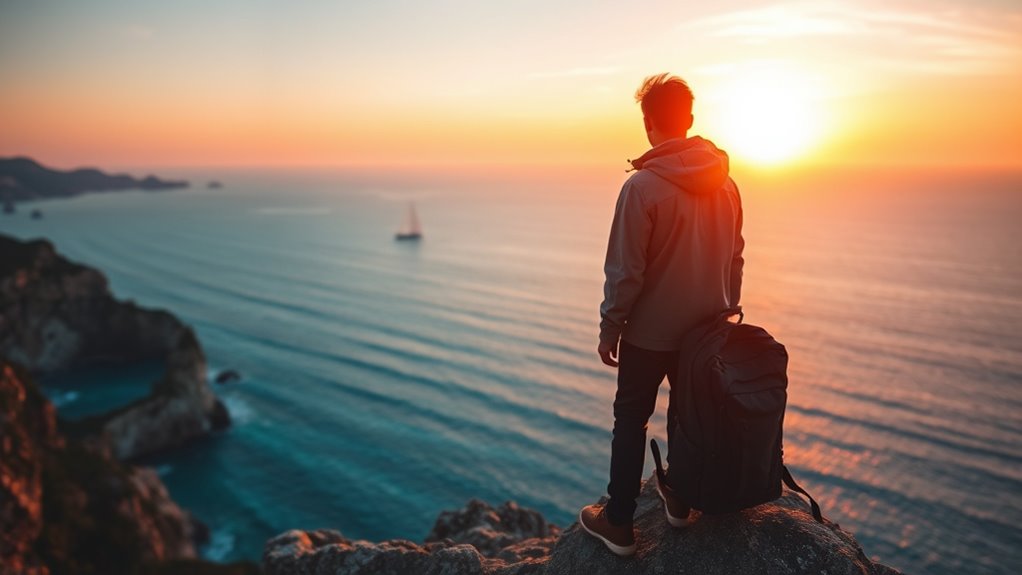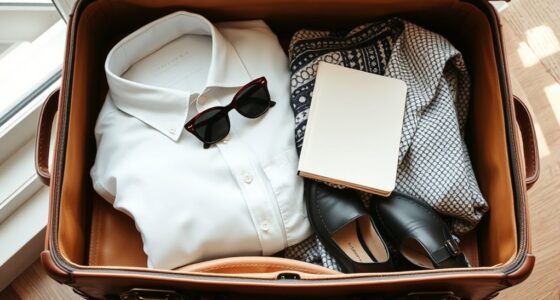Traveling solo can be incredibly rewarding if you plan smartly. Choose safe destinations known for their hospitality and cultural offerings, and stay connected with friends or family. Book accommodations with good reviews and prioritize safety, like secure neighborhoods and reliable transport. Keep your belongings close and be aware of your surroundings. Embrace the freedom to explore at your own pace, and remember, small precautions go a long way. Keep going to uncover more expert tips for a confident, memorable journey.
Key Takeaways
- Research safe destinations known for solo travelers and prioritize those with good safety records and cultural acceptance.
- Plan your itinerary in advance, including accommodations, transportation, and activities, to ensure a smooth trip.
- Keep emergency contacts, copies of important documents, and local emergency numbers accessible at all times.
- Share your travel plans with friends or family and check in regularly to stay connected and ensure your safety.
- Trust your instincts, stay vigilant, and maintain awareness of your surroundings to prevent potential risks.

Ever wondered why more people are choosing to travel solo? The answer lies in the increasing appeal of independence, self-discovery, and flexible adventure. Today, a significant majority of solo travelers are women, comprising about 84%, with men making up roughly 16%. This trend reflects a growing confidence among women to explore the world alone, especially in destinations they perceive as safe, like Europe. Whether you’re planning your first trip or your tenth, understanding these demographics helps tailor your experience, making it more enjoyable and secure. #solotravel hashtag has over 6.5B views on TikTok Many solo travelers plan multiple trips each year. In fact, over 62% intend to take between two to five trips in the upcoming year, and some even aim for four or five trips in just one year. This frequent travel pattern indicates that solo adventures aren’t just a one-off experience but a lifestyle choice for many. Advances in self-planned travel are evident: about one in six solo travelers book their trips independently, and searches for “solo travel deals” and “best solo destinations” have surged by 30%. This rise shows that more travelers are seeking budget-friendly options and personalized itineraries, giving you the freedom to spend as you wish, often around $2,000 to $3,000 weekly, excluding airfare. People are motivated by various desires. The most common activities include cultural sightseeing (74%), nature exploration (71%), and cultural immersion (64%). Many travel solo to relax and unwind (61%), emphasizing the mental health benefits of solitary travel. A substantial 58% of parents use solo trips for personal growth or to explore new interests, highlighting how traveling alone can be a powerful tool for self-development. The trend is so strong that the global market for solo travel was valued at USD 482.5 billion in 2024 and is projected to reach USD 1.5 trillion by 2033, with many travel agents dropping single supplement fees to attract solo travelers. Safety remains a top concern, with nearly half (48%) of solo travelers citing it as their primary worry. To mitigate risks, many choose destinations perceived as safe, particularly in Europe. Solo travel insurance sales are rising, with 70% of policies specifically purchased by solo travelers in 2024, reflecting a growing emphasis on preparedness. Despite these concerns, most women—about 59%—are enthusiastic to travel alone again, thanks to positive experiences and managed risks. Interestingly, cultural narratives in film and media have contributed to changing perceptions about solo travel, making it more appealing and accepted. Additionally, understanding the role of societal perceptions in travel choices can help travelers feel more confident and supported in their journeys. Furthermore, the importance of cultural awareness plays a significant role in ensuring respectful and enriching travel experiences. It is also helpful to be aware of home furnishings safety when staying in accommodations, as it can impact overall comfort and security. Whether you’re exploring cultural cities, engaging in outdoor adventures, or simply seeking solitude, solo travel offers unmatched flexibility. It allows you to immerse yourself in new environments, pursue hobbies, and discover yourself along the way. With proper planning, safety precautions, and an open mind, your solo journey can be one of the most rewarding experiences you’ll ever have.
Frequently Asked Questions
How Do I Choose a Safe Destination for Solo Travel?
When choosing a safe destination, you should research crime rates and safety rankings like the Global Peace Index. Look for countries with good infrastructure and friendly cultural attitudes. Check travel advisories and consider joining solo travel communities for insights. Pick places known for safety, like Iceland or Denmark, where low crime and well-developed services make orienting oneself easier. Always choose destinations that align with your comfort level and personal safety preferences.
What Are Some Budget-Friendly Tips for Solo Travelers?
Imagine you’re a modern-day Marco Polo, exploring on a budget. To save, choose affordable accommodations like hostels or Airbnb, and negotiate longer stays. Use public transit and book flights early for cheap fares. Cook your own meals and visit free attractions to cut costs. Focus on budget-friendly destinations like Southeast Asia or Eastern Europe. Track your spending daily and stay flexible; with smart planning, solo travel becomes both fun and financially manageable.
How Can I Meet People While Traveling Alone?
To meet people while traveling alone, you should participate in group activities like tours or workshops related to your interests. Stay in social accommodations such as hostels or shared spaces, and use travel apps or social media to connect with others before and during your trip. Be open to approaching locals and fellow travelers at cafes or markets, and join local events or meetups—these are great ways to build connections naturally.
What Should I Pack for a Solo Trip?
Thinking about what to pack for a trip? Well, you’ll want versatile clothing like 2-3 pants, 4-5 tops, and a dress or skirt for variety. Don’t forget comfy shoes for walking and a lightweight jacket for surprises. Pack essentials like a backpack, power bank, and travel adapters. It’s all about balancing practicality and style—so you’re prepared without overstuffing and turning your bag into a black hole.
How Do I Handle Emergencies When Traveling Alone?
When handling emergencies while traveling alone, stay calm and act quickly. Research local emergency numbers and keep them handy. Establish rapport with hotel staff or locals for support, and use smart technology to share your location and get alerts. Carry extra money and important documents separately, and develop situational awareness to avoid risky areas. Regular check-ins with a trusted contact can also help make certain you’re safe and prepared.
Conclusion
So, embrace the solitude—after all, what’s more empowering than exploring foreign streets alone? Ironically, the best part of solo travel is realizing you’re never truly alone; your thoughts, adventures, and even the quiet moments become your loyal companions. Sure, going solo might seem intimidating at first, but it’s in those moments of solitude that you discover your true strength. In the end, traveling alone isn’t just about independence—it’s about learning to enjoy your own company.









